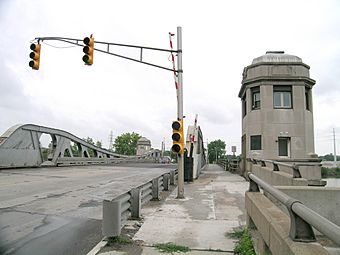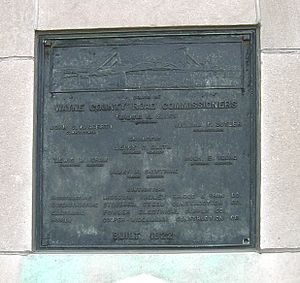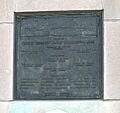West Jefferson Avenue–Rouge River Bridge facts for kids
Quick facts for kids |
|
|
West Jefferson Avenue–Rouge River Bridge
|
|

Rouge River bridge looking west
|
|
| Location | River Rouge, Michigan |
|---|---|
| Built | 1922 |
| Architect | Stroebel Steel Construction Company; Valley Bridge and Iron Company |
| MPS | Highway Bridges of Michigan MPS |
| NRHP reference No. | 00000079 |
| Added to NRHP | February 10, 2000 |
The West Jefferson Avenue–Rouge River Bridge is a special bridge in Michigan. It crosses the Rouge River, connecting the cities of Detroit and River Rouge. This bridge is unique because it's the only "pony truss bascule bridge" still standing in Michigan. A bascule bridge is a type of drawbridge that opens by lifting one or two sections, like a seesaw. It was added to the National Register of Historic Places in 2000, which means it's an important historical landmark.
Contents
Building the Bridge
Before this bridge was built, there were older, narrower bridges at West Jefferson and Fort Streets. These old bridges were "swing bridges," which means they would swing open to let boats pass. By the late 1910s, these bridges were too old and small. They also got in the way of the government's plans to make the Rouge River deeper. Making the river deeper, called "dredging," would allow large ships to reach the Ford River Rouge Complex.
Both the city of Detroit and Wayne County agreed that the county should manage building new bridges. However, laws at the time stopped the county from helping. This changed in 1919 when a new state law was passed.
Planning and Funding
With the new law, plans were made in 1920 for two new "single trunnion, double-leaf bascule bridges." A "trunnion" is like a large axle that the bridge parts pivot on, and "leaves" are the moving sections of the bridge. The estimated cost for both bridges was $2 million. Voters in Wayne County approved a "bond issue" to pay for the construction. A bond issue is a way for the government to borrow money from people to pay for big projects.
A temporary route was set up for Jefferson Avenue traffic. Wayne County used an old bridge from the Michigan Central Railroad. They floated this old bridge downstream and placed it near Jefferson Avenue. The old Jefferson Avenue bridge closed on November 13, 1920, and the temporary route opened.
Construction Begins
Work on the new bridge started right away. Each moving part of the bridge, called a "leaf," needed strong support. These supports were made of four large concrete blocks, each 12 feet square. They were sunk about 70 feet (21 meters) deep into the bedrock below the water. These blocks supported a concrete pit, 50 by 80 feet (15 by 24 meters), which held the heavy "counterweights" and the machinery that moved the bridge. Counterweights are heavy objects that balance the weight of the bridge leaves, making them easier to lift.
Several companies worked on the bridge:
- The Missouri Valley Bridge and Iron Company built the "substructure" (the parts of the bridge below the road) for $408,280.
- The Strobel Steel Construction Company built the "superstructure" (the parts of the bridge above the road) for $378,005.
- Cooper-Widenmann Construction Company built the "operators' houses" (where the bridge tenders work) for $78,700.
- Fowler Electrical Supply Company provided the electrical equipment for $34,809.
- County workers prepared and paved the "approaches," which are the roads leading up to the bridge.
Opening and Repairs
On August 21, 1922, the two moving leaves of the bridge were lowered together for the first time. The bridge officially opened to traffic on October 17. Work on the roads leading to the bridge was still ongoing, but the temporary bridge had problems, so the new bridge had to open early. The next year, the federal government finished making the Rouge River deeper.
In the early 1980s, Wayne County spent $2.2 million to repair parts of the West Jefferson Bridge. These repairs changed the bridge a little, but it still shows important engineering from the early 1900s.
On May 12, 2013, the West Jefferson Avenue bridge closed unexpectedly while a large ship, the Herbert C Jackson, was passing. This was due to a problem with the bridge operator. The bridge stayed in the raised position after this incident. Plans were made to fix the bridge and reopen it in 2016. The bridge was successfully reopened on August 11, 2016.
Images for kids




